NCERT Solutions for Class 12 Maths Chapter 10 - Vectors - Exercise 10.2
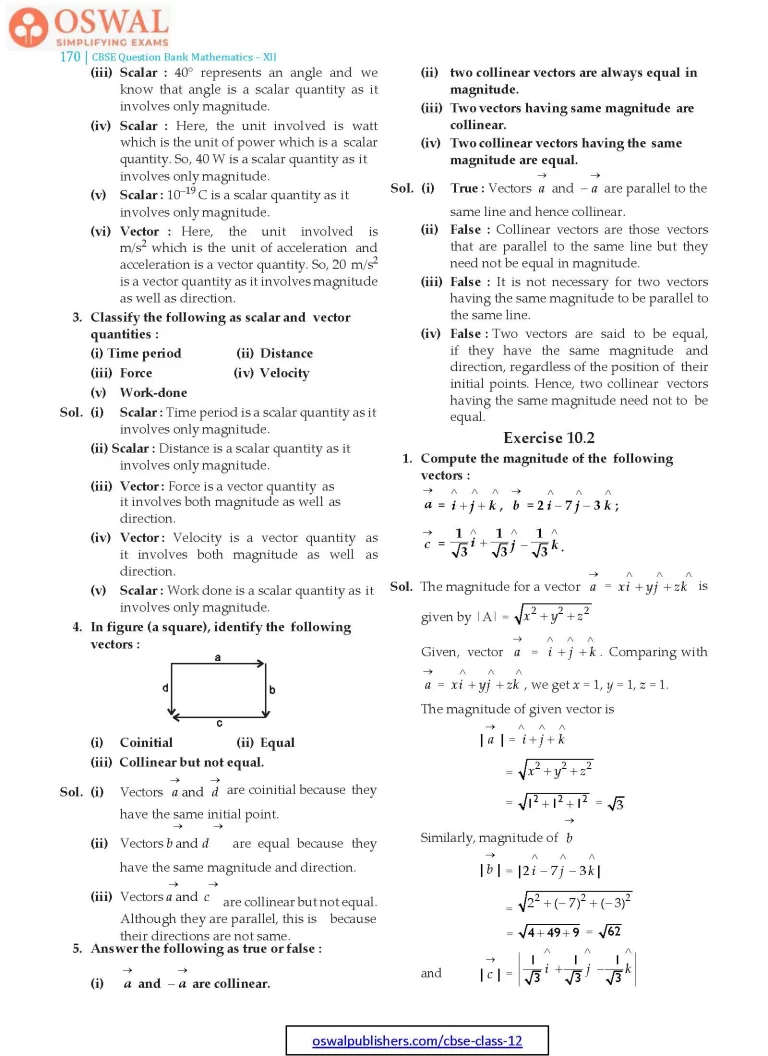
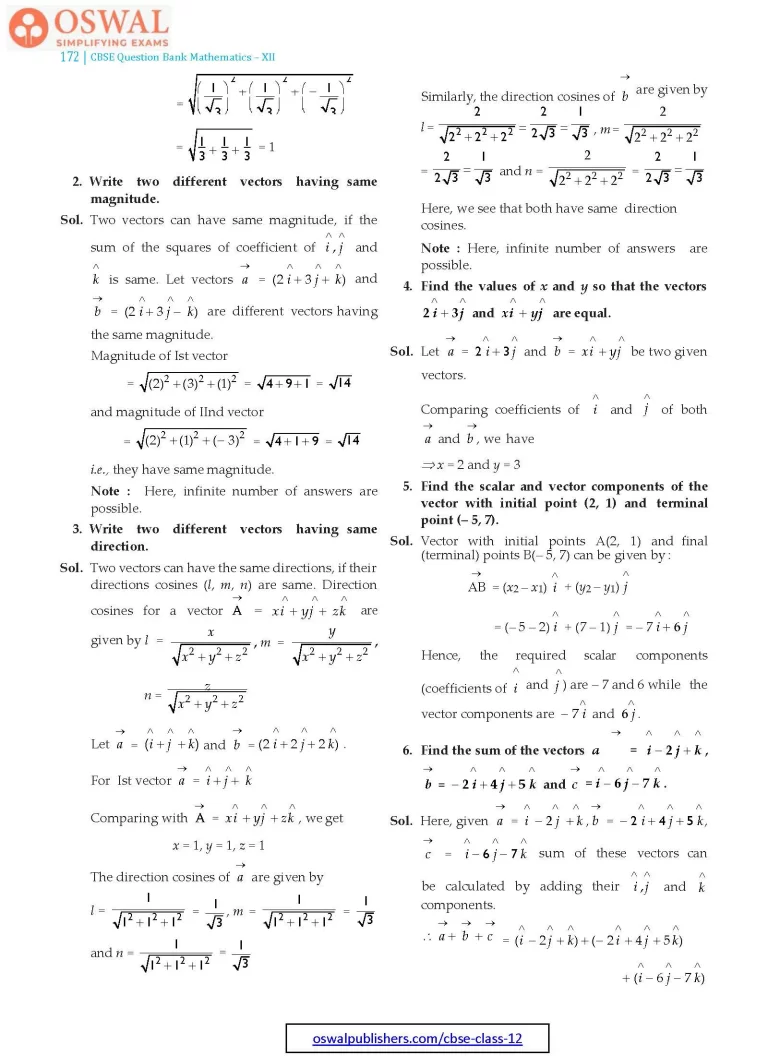
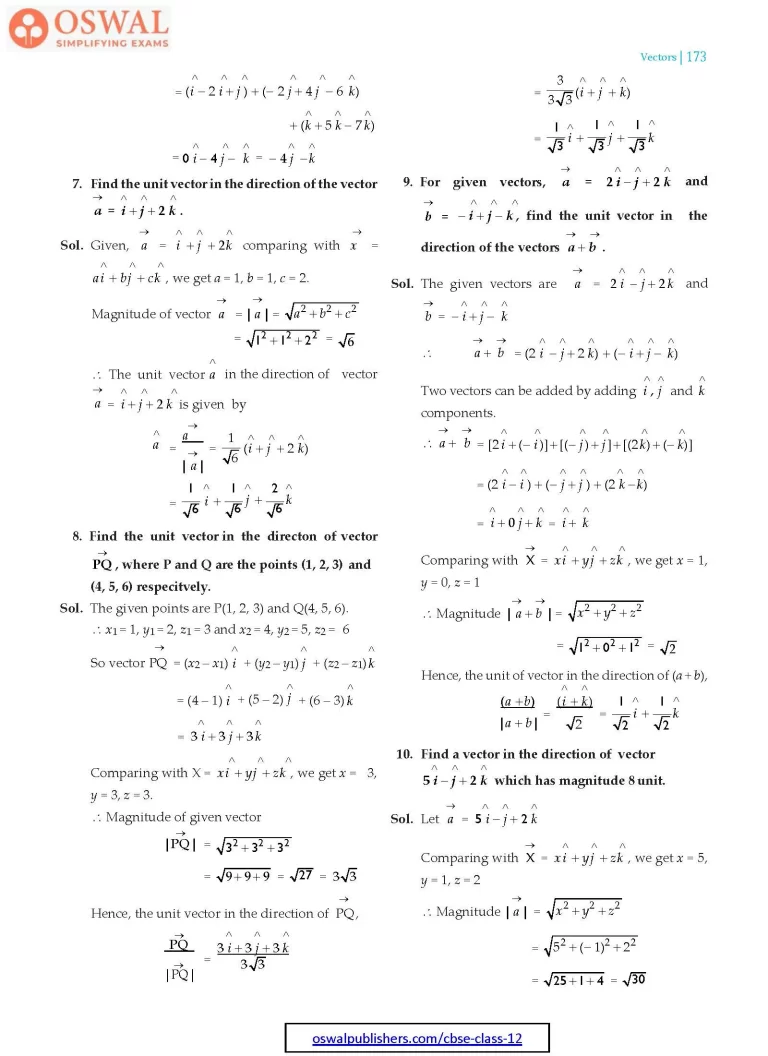
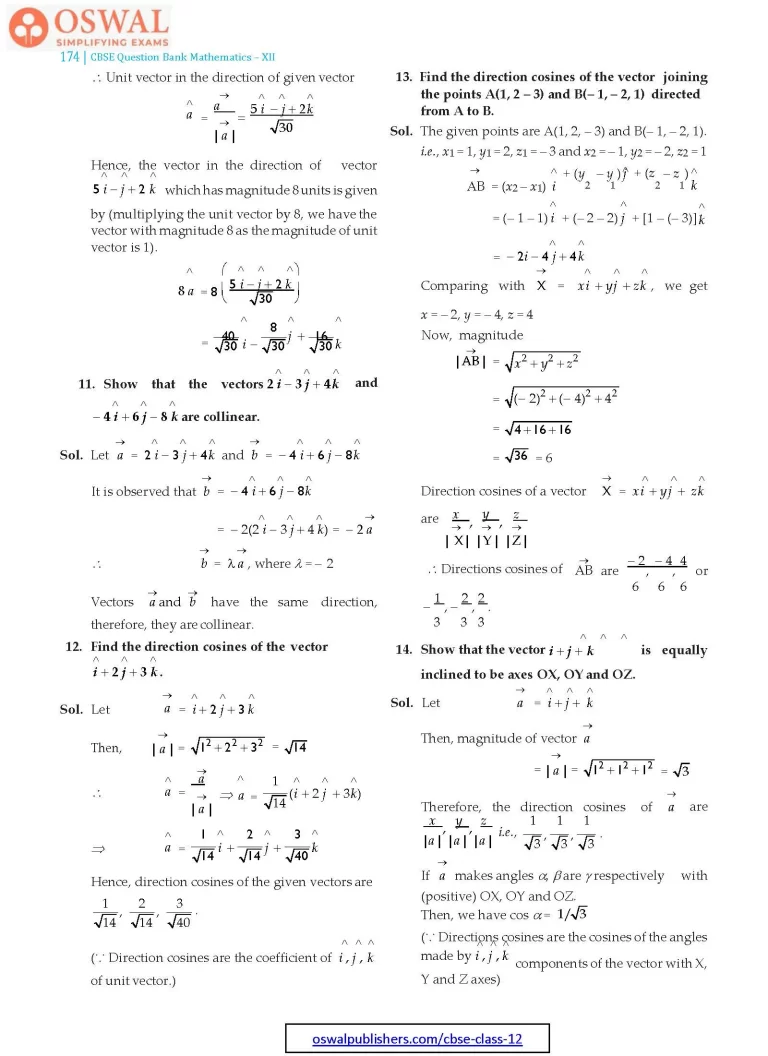
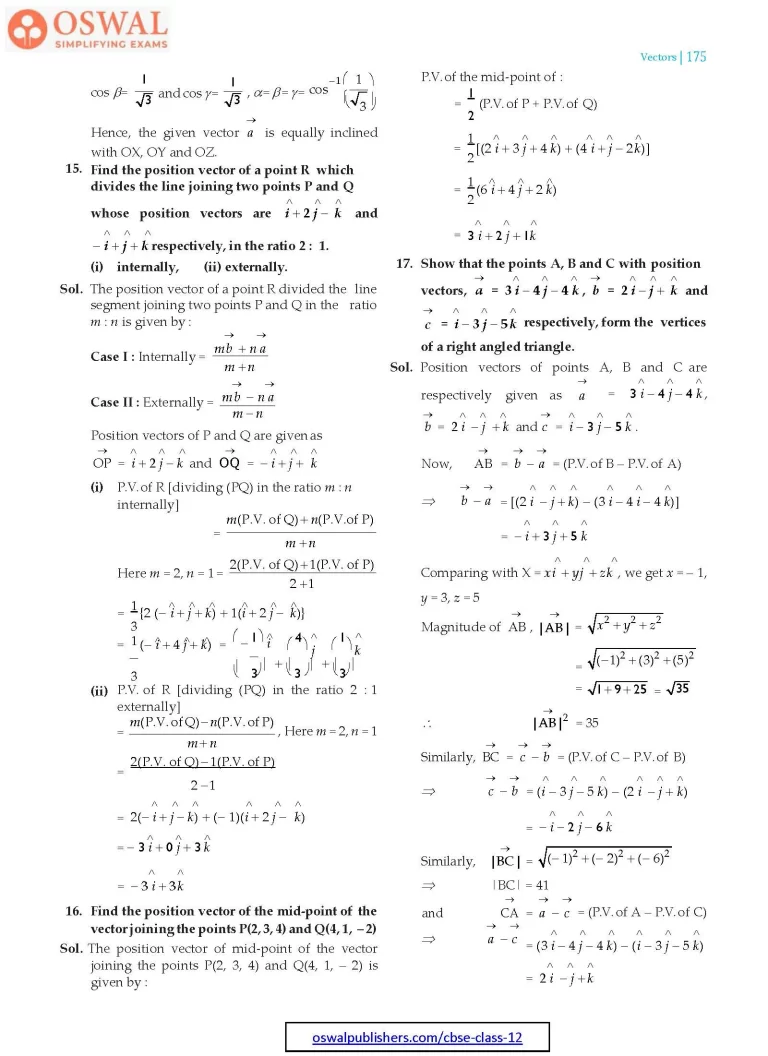
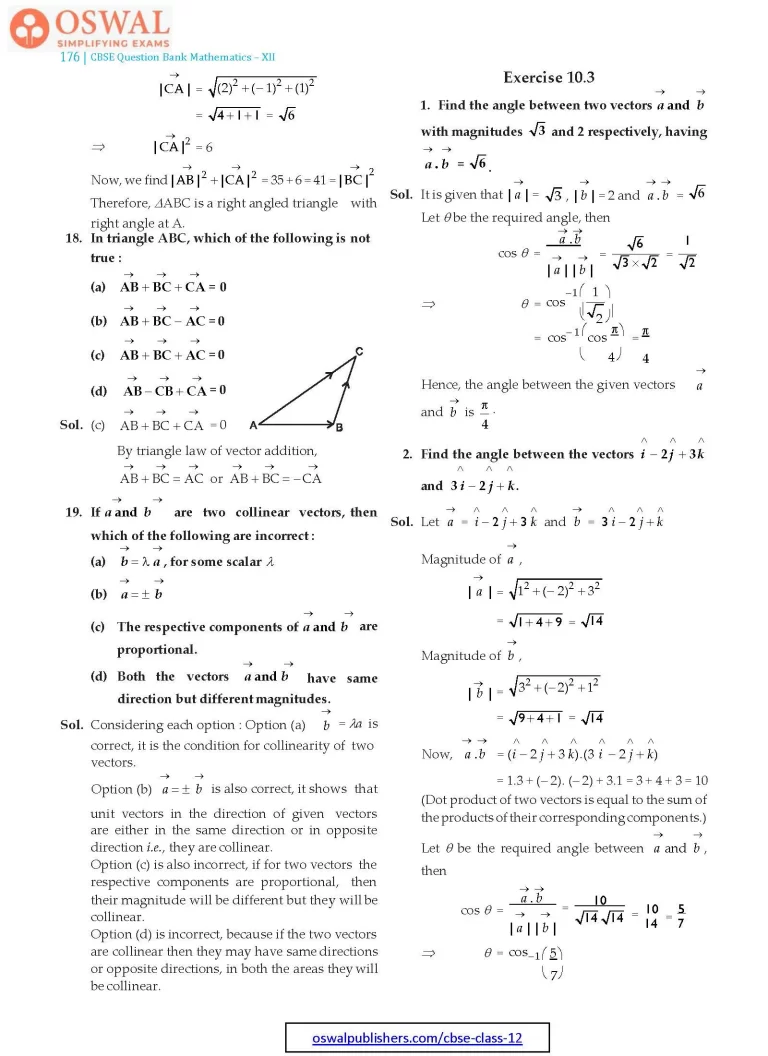
Access Exercises of Class 12 Maths Chapter 10 – Vectors
Exercise 10.1 Solutions 5 Questions
Exercise 10.2 Solutions 19 Questions
Exercise 10.3 Solutions 18 Questions
Exercise 10.4 Solutions 12 Questions
Miscellaneous Exercise on Chapter 10 Solutions 19 Questions
Exercise 10.2
1. Compute the magnitude of the following vectors :
$$\vec{\textbf{a}} \textbf{=} \hat{\textbf{i}} \textbf{+} \hat{\textbf{j}} \textbf{+} \hat{\textbf{k}}\textbf{,} \space\vec{\textbf{b}} \textbf{=} \textbf{2}\hat{\textbf{i}}\textbf{-7}\hat{\textbf{j}}\textbf{-3}\hat{\textbf{k}};\\\vec{\textbf{c}} \textbf{=} \frac{\textbf{1}}{\sqrt{\textbf{3}}}\hat {\textbf{i}} + \frac{\textbf{1}}{\sqrt{\textbf{3}}}\hat{\textbf{j}} \textbf{-}\frac{\textbf{1}}{\sqrt{\textbf{3}}}\hat {\textbf{k.}}$$
Sol. The magnitude for a vector
$$\vec{a} = x\hat{i} + y\hat{j} + z\hat{k}\space\text{is given by |A| =}\\\sqrt{x^{2} + y^{2} + z^{2}}\\\text{Given, vector}\space \vec{a}=\hat{i} +\hat{j} + \hat{k}.\\\text{Comparing with}\\\vec{a} = x\hat{i} + y\hat{j} + z\hat{k},\space\\\text{we get x = 1, y = 1, z = 1.}$$
The magnitude of given vector is
$$|\vec{a}| = \hat{i} + \hat{j} + \hat{k}\\=\sqrt{x^{2} + y^{2} +z^{2}}\\=\sqrt{1^{2} +1^{2} + 1^{2}} =\sqrt{3}\\\text{Similarly, magnitude of}\space\vec{b}\\|\vec{b}| = |2\hat{i} -7\hat{j}-3\hat{k}|\\=\sqrt{2^{2} + (\normalsize-7)^{2} + (\normalsize-3)^{2}}\\=\sqrt{4 + 49 +9} = \sqrt{62}\\\text{and}\space|\vec{\text{C}}| = \bigg|\frac{1}{\sqrt{3}}\hat i + \frac{1}{\sqrt{3}}\hat j -\frac{1}{\sqrt{3}}\hat{k}\bigg|\\=\sqrt{\bigg(\frac{1}{\sqrt{3}}\bigg)^{2} + \bigg(\frac{1}{\sqrt{3}}\bigg)^{2} + \bigg(-\frac{1}{\sqrt{3}}\bigg)^{2}}$$
$$=\space\sqrt{\frac{1}{3}+\frac{1}{3}+\frac{1}{3}}=1 $$
2. Write two different vectors having same magnitude.
Sol. Two vectors can have same magnitude, if the sum of the squares of coefficient of
$$\hat{i},\hat{j}\space\text{and}\space\hat{k}\space\text{is same.}\\\text{Let vectors}\space\vec{a} = (2\hat{i} + 3\hat{j}+\hat{k})\space\text{and}\\\vec{b} =(2\hat{i} + 3\hat{j} - \hat{k})$$
are different vectors having the same magnitude.
Magnitude of Ist vector
$$ =\sqrt{(2)^{2} + (3)^{2} + (1)^{2}}\\=\sqrt{4+9+1} = \sqrt{14}$$
and magnitude of IInd vector
$$ = \sqrt{(2)^{2} + (1)^{2} + (-3)^{2}}\\=\sqrt{4+1+9} =\sqrt{14}$$
i.e., they have same magnitude.
Note : Here, infinite number of answers are possible.
3. Write two different vectors having same direction.
Sol. Two vectors can have the same directions, if their directions cosines (l, m, n) are same. Direction
$$\text{cosines for a vector}\space\vec{A} = x\hat{i} + y\hat{j} + z\hat{k}\\\text{are given by l =}\frac{x}{\sqrt{x^{2} + y^{2} + z^{2}}},\\m =\frac{y}{\sqrt{x^{2} + y^{2} +z^{2}}},n =\frac{z}{\sqrt{x^{2} + y^{2} + z^{2}}}\\\text{Let}\space \vec{a} = (\hat{i}+\hat{j}+ \hat{k})\space\text{and}\space\vec{b} =(2\hat{i} + 2\hat{j} +2\hat{k}).\\\text{For Ist vector}\space \vec{a} =\hat{i} + \hat{j} +\hat{k}\\\text{Comparing with}\space \vec{A} = x\hat{i} + y\hat{j} +z\hat{k},\\\text{we get x = 1, y = 1, z = 1}\\\text{The direction cosines of}\space\vec{a}\space\text{are given by}\\l = \frac{1}{\sqrt{1^{2} + 1^{2} +1^{2}}} = \frac{1}{\sqrt{3}}, \\m=\frac{1}{\sqrt{1^{2}+1^{2}+1^{2}}}=\frac{1}{\sqrt{3}}$$
$$\text{and n =}\frac{1}{\sqrt{1^{2} +1^{2} +1^{2}}}=\frac{1}{\sqrt{3}}\\\text{Similarly , the direction cosines of}\\\vec{b}\space\text{are given by}\\\text{l =}\frac{2}{\sqrt{2^{2}+2^{2}+2^{2}}} = \frac{2}{3\sqrt{3}}=\frac{1}{\sqrt{3}},\space \\m =\frac{2}{\sqrt{2^{2} + 2^{2}+ 2^{2}}}=\frac{2}{\sqrt{3}} =\frac{1}{\sqrt{3}}\\\text{and n =}\frac{2}{\sqrt{2^{2} +2^{2}+2^{2}} }=\frac{2}{2\sqrt{3}} = \frac{1}{\sqrt{3}} $$
Here, we see that both have same direction cosines.
Note : Here, infinite number of answers are possible.
4. Find the values of x and y so that the vectors
$$2\hat{i} + 3\hat{j}\space\text{and \space} x\hat{i} + y\hat{j}\space\text{are equal.}\\\textbf{Sol.\space}\text{Let}\space\vec{a} = 2\hat{i} + 3\hat{j}\space\text{and}\space\vec{b} = x\hat{i} + y\hat{j}\\\space\text{be two given vectors.}\\\text{Comparing coefficients of}\space\hat{i}\space\text{and}\space\hat{j}\space\text{of both}\\\vec{a}\space\text{and}\space \vec{b},\text{we have}\\\Rarr\space x = 2\text{and y = 3}$$
5. Find the scalar and vector components of the vector with initial point (2, 1) and terminal point (– 5, 7).
Sol. Vector with initial points A(2, 1) and final (terminal) points B(– 5, 7) can be given by :
$$\vec{\text{AB}} = (x_2-x_1)\hat{i} + (y_2-y_1)\hat{j}\\=(-5-2)\hat{i} + (7-1)\hat{i} =-7\hat{i} + 6\hat{j}$$
Hence, the required scalar components
$$(\text{coefficients of}\space \hat{i}\space\text{and}\space\hat{j}\space)\\\text{are – 7 and 6 while the vector}\\\text{components are -7}\hat{i}\space\text{and \space 6}\hat{j}.$$
6. Find the sum of the vectors
$$\vec{\textbf{a}} \textbf{=} \hat{\textbf{i}} \textbf{-2}\hat{\textbf{j}} \textbf{+}\hat{\textbf{k}}\textbf{,}\\\vec{\textbf{b}} \textbf{= -2}\hat{\textbf{i}} \textbf{+ 4}\hat{\textbf{j}} \textbf{+ 5}\hat{\textbf{k}}\space \textbf{and}\\\vec{\textbf{c}} \textbf{=} \hat{\textbf{i}} \textbf{- 6}\hat{\textbf{j}} \textbf{-7}\hat{\textbf{k}}\textbf{.}\\\textbf{Sol.\space}\text{Here, given}\space \vec{a} =\hat{i} -2\hat{j}+\hat{k},\\\vec{b} =-2\hat{i} + 4\hat{j} + 5\hat{k}, \vec{c} = \hat{i}-6\hat{i} -7\hat{k}$$
sum of these vectors can be calculated by adding their
$$\hat{i},\hat{j}\space\text{and}\space\hat{k}\space\text{components.}\\\therefore\space \vec{a} +\vec{b}+\vec{c} = (\hat{i} - 2\hat{j}+\hat{k}) + \\(-2\hat{i} + 4\hat{j} +5\hat{k}) + (\hat{i} -6\hat{j}-7\hat{k})\\=(\hat{i}-2\hat{i}+\hat{j}) + (-2\hat{j} + 4\hat{j}-6\hat{k})+\\(\hat{k}+ 5\hat{k}-7\hat{k})\\=0\hat{i}-4\hat{j}-\hat{k} = -4\hat{j}-\hat{k}$$
7. Find the unit vector in the direction of the vector
$$\vec{\textbf{a}} = \hat{\textbf{i}} \textbf{+} \hat{\textbf{j}} \textbf{+ 2}\hat{\textbf{k}}\textbf{.}\\\textbf{Sol.\space}\text{Given,}\space\vec{a} = \hat{i}+\hat{j}+2\hat{k}\\\text{comparing with}\space\vec{x} = a\hat{i}+b\hat{j}+c\hat{k},\\\text{we get a = 1, b = 1, c = 2.}\\\text{Magnitude of vector}\space\vec{a} = |\vec{a}|\\\sqrt{a^{2} +b^{2}+c^{2}}\\=\sqrt{1^{2}+1^{2}+1^{2}}=\sqrt{6}$$
$$\therefore\space\text{The unit vector}\space\vec{a}\\\space\text{in the direction of vector}\\\vec{a} = \hat{i} + \hat{j}+2\hat{k}\space\text{is given by}\\\hat{a} = \frac{\vec{a}}{|\vec{a}|}=\frac{1}{\sqrt{6}}(\hat{i} + 2\hat{j} + 2\hat{k})\\=\frac{1}{\sqrt{6}}\hat{i} + \frac{1}{\sqrt{6}}\hat{j} + \frac{2}{\sqrt{6}}\hat{k} $$
8. Find the unit vector in the directon of vector$$\vec{\textbf{PQ}},\space \textbf{where P and Q are the points}$$
(1, 2, 3) and (4, 5, 6) respecitvely
Sol. The given points are P(1, 2, 3) and Q(4, 5, 6).
∴ x1 = 1, y1 = 2, z1 = 3 and x2 = 4, y2 = 5, z2 = 6
So vector
$$\vec{\text{PQ}} = (x_2-x_1)\hat{i} + (y_2-y_1)\hat{j}+\\(z_2-z_1)\hat{k}\\=(4-1)\hat{i} + (5-2)\hat{j} + (6-3)\hat{k}\\= 3\hat{i} + 3\hat{j} +3\hat{k}\\\text{Comparing with}\space\text{X} = x\hat{i} + y\hat{j}+z\hat{k},$$
we get x = 3, y = 3, z = 3.
∴ Magnitude of given vector
$$|\vec{\text{PQ}}| = \sqrt{3^{2} + 3^{2}+3^{2}}\\\sqrt{9+9+9} = \sqrt{27} = 3\sqrt{3}$$
$$\text{Hence, the unit vector in the}\\\text{direction of}\space\vec{\text{PQ}},\\\frac{\vec{\text{PQ}}}{|\vec{\text{PQ}}|} = \frac{3\hat{i} + 3\hat{j} + 3\hat{k}}{3\sqrt{3}}\\=\frac{3}{3\sqrt{3}}(\hat{i} + \hat{j} +\hat{k})\\=\frac{1}{\sqrt{3}}\hat{i} +\frac{1}{\sqrt{3}}\hat{j} +\frac{1}{\sqrt{3}}\hat{k} $$
$$\textbf{9. For given vectors,}\space\vec{\textbf{a}}\textbf{= 2}\hat{\textbf{i}} \textbf{-}\hat{\textbf{j}} \textbf{+ 2}\hat{\textbf{k}}\\\textbf{and}\space\vec{\textbf{b}}\space\textbf{=}\space\hat{\textbf{-i}} \textbf{+} \hat{\textbf{j}}\textbf{-}\hat{\textbf{k}},\space\textbf{find the unit vector}\\\textbf{in the direction of the vectors}\space\vec{\textbf{a}} +\vec{\textbf{b}}.$$
Sol. The given vectors are
$$\vec{a} = 2\hat{i} - \hat{j} + 2\hat{k}\space\text{and}\space\vec{b} = -\hat{i} + \hat{j}-\hat{k}\\\therefore\space\vec{a}+\vec{b} = (2\hat{i}-\hat{j}+2\hat{k}) + (-\hat{i} + \hat{j}-\hat{k})\\\text{Two vectors can be added by adding}\\\hat{i},\hat{j}\text{and}\hat{k}\space\text{components.}\\\therefore\space \vec{a}+\vec{b} =\lbrack2\hat{i} + (-\hat{i})\rbrack + \lbrack(-\hat{j})+\hat{j} \rbrack+\\\lbrack(2\hat{k}) + (-\hat{k})\rbrack\\=(2\hat{i} - \hat{i}) + (-\hat{j}+\hat{j})+(2\hat{k}-\hat{k})\\=\hat{i} + 0\hat{j}+\hat{k} =\hat{i}+\hat{k}\\\text{Comparing with}\space\vec{\text{X}}= x\hat{i} + y\hat{j}+z\hat{k},\\\text{we get x = 1, y = 0, z = 1}\\\therefore\space\text{Magnitude}|\vec{a}+\vec{b}| = \sqrt{x^{2} + y^{2}+z^{2}}\\=\sqrt{1^{2} + 0^{2}+1^{2}} = \sqrt{2}$$
Hence, the unit of vector in the direction of (a + b),
$$\frac{(a+b)}{|a+b|} = \frac{(\hat{i} + \hat{k})}{\sqrt{2}}\\=\frac{1}{2}\hat{i}+ \frac{1}{\sqrt{2}}\hat{k}$$
10. Find a vector in the direction of vector
$$\textbf{5}\hat{\textbf{i}}\space\textbf{- j}\textbf{+ 2}\hat{\textbf{k}}\space\textbf{which has magnitude 8 unit.}$$
$$\textbf{Sol.\space}\text{Let}\space \vec{a} = 5\hat{i} -\hat{j}+2\hat{k}\\\text{Comparing with}\space\vec{\text{X}} = x\hat{i}+ y\hat{j}+z\hat{k},\\\text{we get x = 5, y = 1, z = 2}\\\therefore\space\text{Magnitude}\space|\vec{a}| = \sqrt{x^{2} + y^{2} +z^{2}}\\=\sqrt{5^{2} + (\normalsize-1)^{2}+2^{2}}\\=\sqrt{25+1+4}=\sqrt{30}$$
∴ Unit vector in the direction of given vector
$$\hat{a} = \frac{\vec{a}}{|\vec{a}|}=\frac{5\hat{i}-\hat{j}+2\hat{k}}{\sqrt{30}}$$
Hence, the vector in the direction of vector
$$5\hat{i}-\hat{j}+2\hat{k}\space\text{which has magnitude}$$
8 units is given by (multiplying the unit vector by 8, we have the vector with magnitude 8 as the magnitude of unit vector is 1).
$$8\hat{a} =\bigg(\frac{5\hat{i}-\hat{j}+2\hat{k}}{\sqrt{30}}\bigg)\\=\frac{40}{\sqrt{30}}\hat{i}-\frac{8}{\sqrt{30}}\hat{j}+\frac{16}{\sqrt{30}}\hat{k}$$
11. Show that the vectors
$$\textbf{2}\hat{\textbf{i}}\space\textbf{- 3j}\space\textbf{+}\space \textbf{4}\hat{\textbf{k}}\space\textbf{and}\space \textbf{-4}\hat{\textbf{i}}\textbf{+ 6}\hat{\textbf{j}}\textbf{- 8}\hat{\textbf{k}}\space\\\textbf{are collinear.}$$
$$\textbf{Sol.}\space \text{Let}\space \vec{a} = 2\hat{i}-3\hat{j}+4\hat{k}\space\text{and}\\\space \vec{b} =-4\hat{i} +6\hat{j}-8\hat{k}\\\text{It is observed that}\\\vec{b} =-4\hat{i}+6\hat{j}-8\hat{k}\\=-2(2\hat{i}-3\hat{j}+4\hat{k})=-2\vec{a}\\\therefore\space \vec{b} =\lambda\vec{a},\space\text{where}\space\lambda=-2\\\text{Vectors\space}\vec{a}\text{and}\space\vec{b}\space\text{have the same direction,}$$
therefore, they are collinear.
12. Find the direction cosines of the vector
$$\hat{\textbf{i}}\textbf{+2}\hat{\textbf{j}}\textbf{+3}\hat{\textbf{k}}\textbf{.}$$
$$\textbf{Sol.\space}\text{Let}\space \vec{a} = \hat{i}+2\hat{j}+3\hat{k}\\\text{Then,}\space |\vec{a}|=\sqrt{1^{2}+2^{2}+3^{2}}=\sqrt{14}\\\therefore\space\hat{a}= \frac{\vec{a}}{|\vec{a}|}\Rarr\space \hat{a} =\frac{1}{\sqrt{14}}(\hat{i}+ 2\hat{j}+3\hat{k})\\\Rarr\space \hat{a} =\frac{1}{\sqrt{14}}\hat{i}+\frac{2}{\sqrt{14}}\hat{j}+\frac{3}{40}\hat{k}$$
Hence, direction cosines of the given vectors are
$$\frac{1}{\sqrt{14}},\frac{2}{\sqrt{14}},\frac{3}{\sqrt{40}}.$$
(∵ Direction cosines are the coefficient of
$$\hat{i},\hat{j},\hat{k}\space\text{of unit vector.)}$$
13. Find the direction cosines of the vector joining the points A(1, 2 – 3) and B(– 1, – 2, 1) directed from A to B.
Sol. The given points are A(1, 2, – 3) and B(– 1, – 2, 1).
i.e., x1 = 1, y1 = 2, z1 = – 3 and x2 = – 1, y2 = – 2, z2 = 1
$$\vec{\text{AB}} = (x_2-x_1)\hat{i} + (y_2-y_1)\hat{j}+\\(z_2-z_1)\hat{k}\\=(-1-1)\hat{i}+(2-2)\hat{j}+\\\lbrack1 -(-3)\rbrack\hat{k}$$
$$= -2i-4\hat{j} + 4\hat{k}$$
$$\text{Comparing with}\space\vec{\text{X}}= x\hat{i}+y\hat{j}+z\hat{k},$$
we get x = – 2, y = – 4, z = 4
Now , magnitude
$$|\vec{\text{AB}}| =\sqrt{x^{2}+y^{2}+z^{2}}\\=\sqrt{(-2)^{2}+(-4)^{2}+4^{2}}\\=\sqrt{4+16+16}\\=\sqrt{36}=6$$
Direction cosines of a vector
$$\vec{\text{X}} = x\hat{i} + y\hat{j}+z\hat{k}\space\text{are}\space\frac{x}{|\vec{\text{X}}|},\frac{y}{|\vec{\text{Y}}|},\frac{z}{|\vec{\text{Z}}|}$$
$$\therefore\space \text{Directions cosines of}\space\vec{\text{AB}}\space\text{are}\\\frac{-2}{6},\frac{-4}{6},\frac{4}{6}\space\text{or}\space-\frac{1}{3},-\frac{2}{3},-\frac{2}{3}.$$
14. Show that the vector
$$\hat{\textbf{i}}+\hat{\textbf{j}}+\hat{\textbf{k}}\space\textbf{is equally inclined}\\\textbf{to be axes OX, OY and OZ.}\\\textbf{Sol.}\space\text{Let\space}\vec{a} = \hat{i}+\hat{j}+\hat{k}\\\text{Then, magnitude of vector}\space\vec{a}\\=|\vec{a}| = \sqrt{1^{2}+1^{2}+1^{2}}=\sqrt{3}$$
Therefore, the direction cosines of
$$\vec{a}\space\text{are}\space\frac{x}{|a|},\frac{y}{|a|},\frac{z}{|a|}\text{i.e.,}\frac{1}{\sqrt{3}},\frac{1}{\sqrt{3}},\frac{1}{\sqrt{3}}.$$
$$\text{If}\space\vec{a}\space\text{makes angles}\space\alpha,\beta\space\text{and}\gamma\space$$
respectively with (positive) OX, OY and OZ.
Then, we have
$$\text{cos}\space\alpha = \frac{1}{\sqrt{3}}$$
$$(∵ \text{Directions cosines are the cosines}\\\text{ of the angles made by}\space \hat{i},\hat{j},\hat{k}\space\text{components}\\\text{of the vector with X, Y and Z axes)}$$
$$\text{cos}\space\beta =\frac{1}{\sqrt{3}}\space\text{and cos}\space\gamma=\frac{1}{\sqrt{3}},\\\alpha = \beta=\gamma =\text{cos}^{\normalsize-1}\bigg(\frac{1}{\sqrt{3}}\bigg)$$
Hence, the given vector $$\vec{a}\space\text{is equally inclined with}\\\text{ OX, OY and OZ.}$$
15. Find the position vector of a point R which divides the line joining two points P and Q whose position vectors are $$\hat{\textbf{i}} \textbf{+ 2}\hat{\textbf{j}}\space\textbf{-}\space\hat{\textbf{k}}\space\textbf{and}\space \textbf{-}\hat{\textbf{i}}\textbf{+}\hat{\textbf{j}}+\hat{\textbf{k}}\space$$
respectively, in the ratio 2 : 1.
(i) internally,
(ii) externally.
Sol. The position vector of a point R divided the line segment joining two points P and Q in the ratio m : n is given by :
$$\textbf{Case I :}\space\text{Internally =}\frac{m\vec{b}+n\vec{a}}{m+n}\\\textbf{Case II :}\space\text{Externally} = \frac{m\vec{b}-n\vec{a}}{\text{m-n}}$$
Position vectors of P and Q are given as
$$\vec{\text{OP}} =\vec{i}+2\vec{j}+\vec{k}\space\text{and}\\\space\vec{\text{OQ}} = -\vec{i}+\vec{j}+\vec{k}$$
(i) P.V. of R [dividing (PQ) in the ratio m : n internally]
$$=\frac{m(\text{P.V of Q}) + n(\text{P.V. of P})}{\text{m+n}}\\\text{Here m = 2, n = 1 =}\\\frac{2(\text{P.V. of Q}) +1(\text{P.V. of P})}{2+1}\\=\frac{1}{3}\lbrack2(-\hat{i} + \hat{j}+\hat{k})+1(\hat{i}+ 2\hat{j}-\hat{k})\rbrack\\=\frac{1}{3}(-\hat{i}+4\hat{j}+\hat{k})=\bigg(-\frac{1}{3}\bigg)\hat{i}+\bigg(\frac{4}{3}\bigg)\hat{j}+\\\bigg(\frac{1}{3}\bigg)\hat{k}$$
(ii) P.V. of R [dividing (PQ) in the ratio 2 : 1 externally]
$$=\frac{m(\text{P.V of Q})-n(\text{P.V of P})}{\text{m+n}},\\\text{Here m = 2, n = 1}\\=\frac{2(\text{P.V. of Q})-1(\text{P.V.}\text{of P})}{2-1}$$
$$= 2(-\hat{i} +\hat{j}+\hat{k})+(\normalsize-1)(\hat{i}+2\hat{j}-\hat{k})$$
$$= -3\hat{i}+ 0\hat{j} + 3\hat{k}\\=3\hat{i}+3\hat{k}$$
16. Find the position vector of the mid-point of the vector joining the points P(2, 3, 4) and Q(4, 1, – 2)
Sol. The position vector of mid-point of the vector joining the points P(2, 3, 4) and Q(4, 1, – 2) is given by :
P.V. of the mid-point of :
$$=\frac{1}{2}(\text{P.V. of P + P.V. of Q})\\=\frac{1}{2}\lbrack(2\hat{i}+3\hat{j}+4\hat{k})+(4\hat{i}+\hat{j}-2\hat{k})\rbrack\\=\frac{1}{2}(6\hat{i}+4\hat{j}+2\hat{k})\\= 3\hat{i}+2\hat{j}+1\hat{k}$$
17. Show that the points A, B and C with position vectors,
$$\vec{\textbf{a}} \textbf{= 3}\hat{\textbf{i}}\textbf{-4}\hat{\textbf{j}}\textbf{-4}\hat{\textbf{k}}\textbf{,}\space\vec{\textbf{b}} \textbf{= 2}\hat{\textbf{i}}\textbf{-}\hat{\textbf{j}}\textbf{+}\hat{\textbf{k}}\\\textbf{and}\space\vec{\textbf{c}}\space\textbf{=}\space\hat{\textbf{i} \text{ - 3}\textbf{j}\textbf{\space-\space5}\hat{\textbf{k}}}$$
respectively, form the vertices of a right angled triangle.
Sol. Position vectors of points A, B and C are respectively given as
$$\vec{a} = 3\hat{i}-4\hat{j}-4\hat{k},\space\vec{b} = 2\hat{i} -\hat{j}+\hat{k}\\\text{and}\space\vec{c} = \hat{i}-3\hat{j}-5\hat{k}.\\\text{Now,\space}\vec{\text{AB}} = \vec{b}-\vec{a} = (\text{P.V.}\text{of B - P.V. of A})\\\Rarr\space \vec{b}-\vec{a} =\lbrack(2\hat{i}-\hat{j}+\hat{k})-(3\hat{i}-4\hat{j}-4\hat{k})\rbrack\\=-\hat{i}+ 3\hat{j}+5\hat{k} $$
$$\text{Comparing with X = x}\hat{i} + y\hat{j}+z\hat{k},\\\text{we get x=-1, y=3,z=5}\\\text{Magnitude of}\space\vec{\text{AB}},|\vec{\text{AB}}|\sqrt{x^{2}+y^{2}+z^{2}}\\=\sqrt{(\normalsize-1)^{2}+(3)^{2}+(5)^{2}}\\=\sqrt{1+9+25}=\sqrt{35}\\\therefore\space|\vec{\text{AB}}|^{2}=35\\\text{Similarly,}\vec{\text{BC}}=\vec{c}-\vec{b}\\=(\text{P.V. of C - P.V. of B})\\\Rarr\space \vec{c}\vec{b}=(\hat{i}-3\hat{j}-5\hat{k})-(2\hat{i}-\hat{j}+\hat{k})\\=-\hat{i}-2\hat{j}-6\hat{k}\\\text{Similarly,}\\\space|\vec{\text{BC}}|=\sqrt{(\normalsize-1)^{2} + (-2)^{2}+(-6)^{2}}$$
$$\Rarr\space |\text{BC}|=41\\\text{and\space}\vec{\text{CA}} = \vec{a}-\vec{c}=\\(\text{P.V. of A – P.V. of C})\\\Rarr\space\vec{a}-\vec{c} = (3\hat{i}-4\vec{j}-4\vec{k})-\\(\hat{i}-3\hat{j}-5\hat{k})\\= 2\hat{i}-\hat{j}+\hat{k}\\|\vec{\text{CA}}| = \sqrt{(2)^{2}+(\normalsize-1)^{2}+(1)^{2}}\\=\sqrt{4+1+1}=\sqrt{6}\\\Rarr\space |\vec{\text{CA}}|^{2}=6\\\text{Now,\space we find}|\vec{\text{AB}}|^{2}+|\vec{\text{CA}}|^{2}\\=35+6=41\\=|\vec{\text{BC}}|^{2}$$
Therefore, Δ ABC is a right angled triangle with right angle at A.
18. In triangle ABC, which of the following is not true :
$$\textbf{(a)\space}\vec{\textbf{AB}}\textbf{+}\vec{\textbf{BC}}\textbf{+}\vec{\textbf{CA}}\textbf{= 0}\\\textbf{(b)\space}\vec{\textbf{AB}}\textbf{+}\vec{\textbf{BC}}\textbf{-}\vec{\textbf{AC}}\textbf{= 0}\\\textbf{(c)\space}\vec{\textbf{AB}}\textbf{+}\vec{\textbf{BC}}\textbf{+}\vec{\textbf{AC}}\textbf{= 0}\\\textbf{(d)\space}\vec{\textbf{AB}}\textbf{-}\vec{\textbf{CB}}\textbf{+}\vec{\textbf{CA}}\textbf{= 0}$$
$$\textbf{Sol.\space}\text{(c)\space}\vec{\text{AB}}+\vec{\text{BC}}+ \vec{\text{CA}}=0$$

By triangle law of vector addition,
$$\vec{\text{AB}}+\vec{\text{BC}} =\vec{\text{AC}}\\\text{or}\space \vec{\text{AB}}+\vec{\text{BC}} =-\vec{\text{CA}}$$
$$\textbf{19.\space}\textbf{If}\space \vec{\textbf{a}}\space\textbf{and}\space\vec{\textbf{b}}\space\textbf{are two collinear vectors,}\\\textbf{then which of the}\\\textbf{following are incorrect :}\\\textbf{(a)\space}\vec{\textbf{b}} =\lambda \vec{\textbf{a},}\space\textbf{for some scalar}\space\lambda\\\textbf{(b)\space}\vec{\textbf{a}} \space\textbf{=} \pm\vec{\textbf{b}}$$
$$\textbf{(c) The respective components of}\\\space\vec{\textbf{a}}\space\textbf{and}\space\vec{\textbf{b}}\space\textbf{are proportional.}\\\textbf{(d)\space}\textbf{Both the vectors}\space\vec{\textbf{a}}\space\textbf{and}\space\vec{\textbf{b}}\space\textbf{have}\\\textbf{same direction but}\\\textbf{different magnitudes.}$$
Sol. Considering each option : Option (a)
$$\vec{b} = \lambda a\space\text{is correct,}$$
it is the condition for collinearity of two vectors.
$$\text{Option (b)}\space\vec{a} = \pm\vec{b}\space \text{is also correct,}$$
it shows that unit vectors in the direction of given vectors are either in the same direction or in opposite direction i.e., they are collinear.
Option (c) is also incorrect, if for two vectors the respective components are proportional, then their magnitude will be different but they will be collinear.
Option (d) is incorrect, because if the two vectors are collinear then they may have same directions or opposite directions, in both the areas they will be collinear.
